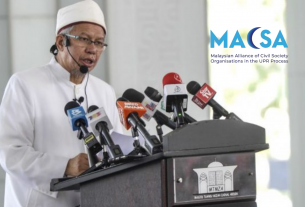We would like to respond to the statement by the Federation of Reproductive Health Associations Malaysia published in Malaymail’s website.
Let us speak plainly and clearly as the above mentioned consensus statement is heavily loaded with jargon and at times unclear and contradictory.
Adolescents and school children must be taught right from wrong. We teach them that certain actions are wrong. For example, stealing is wrong, harming others is wrong, engaging in corruption is wrong, polluting the environment is wrong. Similarly, having sex out of wedlock is also wrong.
We cannot let our formal education system frame sex out of wedlock as a valid lifestyle choice which is ‘acceptable’ as long as condoms are used and ‘consent’ is obtained. Adolescents may subliminally think it is acceptable because of their unrestricted consumption of degenerate entertainment mainly from Western secular culture, but the fact remains that sex out of wedlock is wrong and it is the responsibility of our nation’s educators to be crystal clear about this fact.
Even taking religion out of the equation, historically, thriving human civilisations have always maintained the family structure by censuring sex out of wedlock. For sure there have always been those who fell to temptation, but society has never sanctioned sex out of wedlock as something acceptable until very recently.
For those who do not subscribe to any religious injunctions, aside from the serious issues of pregnancy and sexually-transmitted diseases (STD), there are plenty of logical arguments against the normalisation of sex out of wedlock. The most obvious one is consent.
How are we to tell the difference between ‘consensual’ sex and sexual assault? Not too long ago, Malaysia had its very own #MeToo moment following a flurry of accusations on social media of sexual misconduct. Riding on the wave of confessions following the allegations against Harvey Weinstein and many others around the world, no less than eight men in Malaysia were accused publicly on social media of sexual harassment and assault.
However, just as the #MeToo movement turned a corner with the Aziz Ansari case where a seemingly ‘lacklustre consensual date’ turned into an accusation of sexual assault, the Malaysian version has brought up the controversial issue of sexual consent outside of marriage.
Aziz Ansari is an American actor, writer, producer, director, and comedian who was accused of sexual harassment but he maintained the encounter was “completely consensual.” The complexity of discerning sexual consent is illustrated in this New York Times (NYT) opinion piece.
The current definitions of sexual consent outside marriage are neither robust nor workable. Various infographics and catchy videos try to explain what it is but a cursory search on the web reveals convoluted definitions with sketchy concepts such as ‘enthusiastic consent’, ‘affirmative consent’, ‘reversible consent’, ‘continuous consent’ and other such terminology with impossible legislative functions.
One social media commenter stated her perception of consent was that “consent can be withdrawn at any time, after two minutes or two years or ten years after”. Another said that “a girl can stop consent after eight strokes (thrusts) and that the consent therefore was only for eight strokes”.
With such ambiguous definitions being proposed, it is clear that this type of ‘consent’ cannot do our moral work for us. Where is the line between a consensual and non-consensual sexual encounter? Clearly, the only workable definition of consent is a formal and witnessed one that involves marriage of two people in a stable and loving relationship.
Let us learn from the mistakes of the societies that have already gone down this path. For example, in the United States, where the ghastly ‘hook-up’ culture is now prevalent, there is an epidemic of rape happening on college campuses.
A Department of Justice study in 2007 estimated that one out of 10 undergraduate women had been raped in college. A lot of these cases are not reported to the police and are buried by universities for fear of scandal.
Forced by the federal government, colleges have now gotten into the business of conducting rape trials, but they are not competent to handle this job. They are simultaneously failing to punish violent rapists adequately and at the same time, because of unclear definitions of ‘sexual consent outside of marriage’, particularly when alcohol and drugs are involved, they are branding students as sexual assailants when no sexual assault occurred.
A more recent and comprehensive Washington Post-Kaiser poll in 2015 showed that 1 in 5 college women were sexually assaulted. A major finding of the poll was that: “They are torn over sexual consent. Forty-six per cent said it’s unclear whether sexual activity when both people have not given clear agreement is sexual assault. Forty-seven per cent called that scenario sexual assault.”
Jessica Bennett, the first ever ‘Gender Editor’ of the NYT wrote in 2017 that “In this particular moment of cultural reckoning, it gets at a crucial nuance that seems to have long been missing from the conversation around sexual harassment and assault: that consent isn’t always black and white.”
Let us not go down this path. Our education system should teach students that sexual intimacy should only exist within a legal marriage. Girls should know that there is no ambiguity about who is allowed to touch them intimately, solely the privilege of a legally-wedded husband who has made a commitment to love and protect her for the rest of his life.
It does not include boyfriends, schoolmates, fathers, brothers, cousins, uncles, grandfathers, teachers, coaches, bus drivers, ice cream sellers, mother’s boyfriends and so on.
This is not being ‘judgmental’ or ‘moralising’. It is a robust, workable framework that has been the bedrock of human civilisation for millennia.
Another major reason for objecting to the normalisation of sex outside of marriage is the mental health issues, in particular pertaining to young girls and women.
The sexual revolution’s decoupling of sex from the institutions of marriage and family — with their guardrails of mutual care and fidelity — has resulted in depression, anxiety and other mental health issues particularly for women, who are physiologically primed to bond with someone they are intimate with.
The absence of commitment often leads to the perennial ‘why doesn’t he call’ anxiety and the subsequent mental health consequences. This should not be disregarded merely to uphold the false idol of sexual liberation. Sex outside of marriage has serious non-physical consequences and if we truly cared for our youth, we would not sweep this under the carpet.
In conclusion, when drafting policy to prevent adolescent pregnancy, let’s not think that consent and condoms are the solution to everything. The objective of sex education should be to prevent sex outside of marriage. Address the problem at the source instead of merely applying band-aid solutions.
Let us indeed apply the ‘widest range of health and social policy solutions’ to solve this serious problem rather than half-hearted imitations of failed Western policies.
Injunctions to lower the gaze, to avoid seclusion with members of the opposite sex, and to establish an atmosphere of modesty, mutual respect and dignity are all effective in mitigating sex outside of marriage.
Abstention from alcohol and drugs, and conscious understanding that temptation enters the heart through the eyes and ears will enhance decision-making abilities and enable strictures to attenuate them.
Children and youth must be taught that sex should only exist within the confines of marriage and anything outside of this should set their internal alarm bells ringing. This would aid sex education a great deal instead of trying to teach children the different vague definitions of ‘sexual consent’ which even adults cannot agree on.
At the population level, there is an urgent need for a wholesale reduction of the ‘hypersexual temperature’ of society. We all need to play a collective part in this to protect the vulnerable.
Modest conduct and dressing should be emphasised, sexualised images and sexualised music should be removed from the public sphere, mixed gender interactions kept to only the necessary and most importantly, there need to be serious structural attempts to eliminate pornography.
We cannot expect to live in an historically unprecedented hypersexual environment and then feign surprise when adolescents are getting pregnant by the thousands.
Of course many will object to this in the name of ‘personal freedom’ and ‘individualism’ which are the tenets of a secular liberal worldview. But as the Covid-19 pandemic has taught us, it is a #kitajagakita approach which successfully protects the community. Not #akujagaaku.
Prof Madya Dr Rafidah Hanim Mokhtar
President
International Women’s Alliance for Family Institution and Quality Education (WAFIQ)



